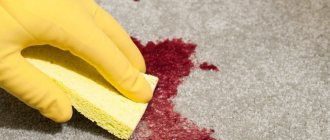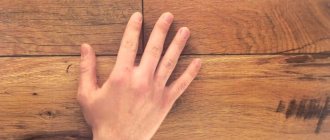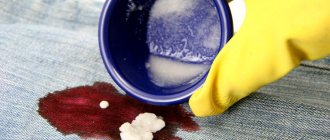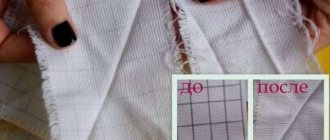Update date: 11/16/2020 16:50:16 82204 Share:
Author: Maria Feldshtein
*Review of the best according to the editors of simplerule.ru. About the selection criteria. This material is subjective in nature, does not constitute advertising and does not serve as a purchase guide. Before purchasing, consultation with a specialist is required.
It is quite difficult to remove blood stains from clothes or upholstered furniture, especially old ones. Even expensive household chemicals cannot cope with this task. Apparently, this is why there are many alternative “folk” methods for removing bloody marks from different types of fabrics and other surfaces. The staff of our magazine found more than a dozen recipes that use inexpensive improvised means and tested the effectiveness of each of them. The effect of store-bought stain removers was also evaluated. The results of the examination and tips for removing fresh and old blood stains are presented below.
How to clean upholstery
How to wash off blood if the upholstery on the sofa is dirty? This is difficult to do because in most cases the upholstery cannot be removed. The stain will have to be wiped over and over again with a cleaning solution and blotted with a dry towel or napkin. Things to consider:
- you cannot clean the upholstery against lint;
- the cleaning agent is first applied to the sponge and then to the contaminated area;
- Before use, any composition should be tested on an inconspicuous area of the upholstery;
- Do not use too hot water, otherwise the blood will penetrate into the tissue even more.
The easiest way to get rid of scarlet marks is with hydrogen peroxide. To clean a sofa or chair, simply moisten a cotton swab with the solution and carefully begin to treat the stain. To prevent it from spreading and increasing in size, this must be done in the direction from the edges to the center. After 5-10 minutes, blot the treated area with a dry towel and repeat the operation again.
Washing sheets with dried blood
Often blood is discovered late, for example, a sheet is stained at night during menstruation. By morning it dries and eats into the fabric structure. If this happens, you should soak the item in cold water for several hours. The modern detergent market offers a large selection of softening options. Folk tips for removing blood recommend adding 3-4 crushed aspirin tablets or 1 teaspoon of citric acid to water.
After the fibers and stain have softened, a stain remover is applied. The above methods are good for blood stains that are not too dry.
For completely dried contaminants, the exposure time is 1.5-2 times longer. Also remember that it is necessary to repeat the cleaning procedure 2-3 times. Old stains are removed by rubbing with a brush. For this purpose, use an old toothbrush.
How to clean a carpet
Bloody marks are difficult to remove from carpet due to the fleecy surface. In addition, often the carpet has a variegated color, against which it is not immediately possible to see the burgundy drops.
It's easier to remove blood from carpet before it has time to dry.
Here are two options for carpet cleaning.
- Aspirin. To make a cleaning solution, drop an aspirin tablet into a soda and stir thoroughly. Saturate the contaminated area with the resulting mixture, and after twenty minutes, thoroughly wipe the area with a hard sponge. Then wash off any remaining dirt and dry the carpet with a hairdryer.
Making a cleaning solution from aspirin and sparkling water - Laundry soap. A good remedy if the burgundy drops on the carpet are fresh. Wipe the stained area with a well-soaped hard sponge. The foam should cover the entire stain for 5-10 minutes, after which the residue is simply washed off.
Laundry soap foam will help deal with fresh stains
You can also make a solution of 0.5 liters of cold water and 1 tbsp. l ammonia to remove stains from the carpet
If the above methods do not work, use store-bought stain removers or go to a dry cleaner.
How to remove fresh blood stains
If you have a blood stain on your clothing, immediately wash it with cold water.
Important! Never try to remove blood with hot water.
This approach will make the situation worse. Below are the most popular methods for removing stains at home in full detail.
Hydrogen peroxide
- After soaking with cold water, pour hydrogen peroxide or chlorhexidine into the dirt. Be careful not to allow any liquid to come into contact with the clean surface, as this may cause the fabric to fade.
- Wait 25-30 minutes.
- Blot the area to be treated with a paper towel or clean, white rag.
- The stain should become lighter or disappear. For complete removal, wash the entire product in the washing machine or by hand as you usually do.
IMPORTANT: Hydrogen peroxide can be replaced with table vinegar or sparkling water.
Ammonia
How to wash blood from a sheet is a pressing question for many girls during menstruation. Fresh blood stains can be easily removed with ammonia.
Articles on the topic (click to view)
- How to become a great lawyer?
- All the pros and cons of forged beds in the interior
- 29 years - Velvet wedding: description, meaning, options for celebration and gifts
- Why are solid doors better?
- Features of pool paths
- Green kitchen interior
- Fences for parking lots and parking areas
Ammonia is too caustic, so it is not recommended to use it in its pure form - it must be diluted.
One convenient option is glass cleaner. It contains ammonia, as well as fragrances that help quickly remove old dirt. To do this, wet the cloth with cold water, then spray the spray on the problem area. Leave for 15 minutes. When it becomes paler, wash it with laundry soap.
If the fresh blood stain is too large, you can use diluted ammonia. To do this, dilute 30 ml of liquid in 220 ml of distilled water. Use a spray bottle to apply. This way the product will be distributed evenly. After 40-50 minutes, blot the area with a clean rag and wash the clothes in cold water.
IMPORTANT: Ammonia will corrode colored fabric, destroying the paint.
Baking soda
A paste is prepared from baking soda and water, which is carefully applied with a toothbrush to a fresh stain.
Then iron the area with a white cotton cloth and leave it to dry in the open air.
Baby powder and corn starch are used in a similar way.
Salt
Salt, combined with the harsh environment of liquid soap or dishwashing detergent, does an excellent job of removing fresh blood on clothes. Leave the mixture on for 30 minutes and then simply rinse with cold water.
Natural stain remover
Supporters of environmentally friendly products will really like this method. A simple, gentle stain remover is made from:
- 30 g baking soda;
- 30 g chlorhexidine;
- 15 g cold water.
The mixture is shaken, then applied in an even layer. Exposure to the mixture is allowed for no more than 10 minutes, then it is washed off. If the stain does not disappear, repeat the procedure 2-3 more times.
Instead of soda, you can use citric acid. This solution removes stains from cotton.
Bleach, commercial stain remover
Purchased products for removing even fresh stains must be used correctly. First, pour a little stain remover onto the stained area and leave for 30 minutes. Then scrub and rinse with cold water. Refill and rinse the entire item thoroughly.
IMPORTANT: Laundry should dry naturally, without using batteries or strong hot air.
Rules for removing old traces of blood
The special composition of blood makes it difficult to remove traces of it from tissue. By reacting with oxygen, the protein is eaten into the fibers, and iron has strong coloring properties and leaves its mark throughout the entire thickness of the material. Over time, the protein coagulates and the contaminant becomes firmly attached to the fibers of the fabric. Therefore, simple washing with conventional detergents does not bring satisfactory results. Only the surface layer of the stain is washed off, and the main contamination in the thickness of the material remains in place.
Important! Even old bloody marks should not be poured with hot water. It will cause the protein to coagulate and the contamination will become impossible to remove.
When removing old traces of blood, follow the rules:
- use cool water, since hot water only fixes the mark more firmly in the fabric, and ice water brings a positive result only for fresh contamination;
- do not iron the item until the bloody trace is removed; high temperature leads to the coagulation of the protein;
- aggressive stain removers are first used on an inconspicuous area to test their effect on the fabric structure;
- After removing the blood, the item is rinsed in cool water to restore the brightness of the shades.
How to remove blood from a sheet in a washing machine
The modern world surrounds people with devices that make life much easier. Unfortunately, thoughtlessly used stain removal mode of the washing machine will not be able to remove blood from the sheets.
Before throwing the sheet into the washing machine, apply stain remover to the stained area. It is best to use a spray. After 20-30 minutes, scrub the area. If the stain has faded, feel free to apply the bleach or stain remover again, and then put the sheet in the drum.
The mode is always selected 30-40°C, with spinning, but without drying. The higher the wash temperature, the more likely it is that blood will be absorbed more. It is very difficult to remove stubborn stains.
Removing blood from a terry sheet should be considered separately. Terry has a natural cotton composition and an original looped structure. Dirt particles cling to fabric loops, therefore, they cannot be removed without first soaking.
IMPORTANT: If the sheet removed from the drum is still dirty, apply the paste and soda to the surface again. Place a white cloth on top and iron with a lukewarm iron. The blood will remain on the rag.
Features of removal from various tissues
Removing traces of corrosion from fabric must be carried out not only taking into account the degree of contamination, but also taking into account the quality and color of the material. In order not to damage the structure of the fibers and maintain the shade, you should choose the right cleaner:
Black fabrics
The presence of dark pigment requires careful use of potent agents. Such things are treated with glycerin compounds, toothpaste, diluted vinegar
The use of bleach and strong acids is unacceptable.
Colored products. Clothing with a pattern belongs to the “complex” group. Many bleaches can worsen the color, so choose only those products that are gentle. Recipes with vinegar, glycerin, and toothpaste are suitable for colored ones. Colored items should not be left in the sun and treated with whiteness.
White linen. If the light-colored fabric is of natural origin (cotton, linen, viscose), then chlorine-containing or acid bleaches can be used to clean it. Citric and oxalic acids are allowed as home remedies.
Jeans. The thick fabric from which jeans are made is difficult to clean. To remove rust marks, use products with good penetrating ability. Vinegar, citric acid, and household chemicals are suitable.
Synthetics. Thin fabrics made from artificial fibers are sensitive to strong reagents. It is recommended to clean them using universal liquids or mixtures based on glycerin, vinegar, and citric acid.
Cotton, linen. Natural fabrics withstand organic acids (citric, oxalic, acetic). Household chemicals intended for these fabrics are also suitable.
Silk, satin. Delicate tissues do not tolerate aggressive substances and strong mechanical stress in the form of friction. To clean them, neutral, mild-acting compounds are used.
Delicate fabrics are especially sensitive to many chemicals, so it is better to take an expensive item to the dry cleaner.
Special household chemicals
To clean blood stains at home, use stain removers. If, when applying detergent, foam appears and sounds resembling hissing are heard, it means that the cleaner has reacted with contaminating components. When the external manifestations of the reaction disappear, the drug begins to be washed off. First, a reduced concentration of the substance is tested on an inconspicuous fragment. If the blots have disappeared and the material is not damaged, the saturation of the solution is not changed. If dirt remains or mechanical damage appears (holes, abrasions), the special product should be replaced.
The product cleans even pleated clothing and parts
Spray Amway SA8
Removes stubborn organic marks from non-fading fabric without rubbing. The dirty area is sprayed and wet treatment is immediately carried out (sometimes old splashes are re-treated). The substance smells delicious of citrus fruits. Hypoallergenic, suitable for caring for children's underwear.
Directional stain remover dr Beckmann
A chlorine-free liquid that removes protein-based splashes and gently cleanses the surface of bloody stains. The cleaner is applied to the dirty area for 10 minutes, then washed as usual. Suitable for cleaning thick and thin, white and colored fabrics. Contains enzymes. Do not treat carpets or leather.
Vanish gold oxidation
They produce oxygen-containing powders and gels for treating white and colored items. Apply pointwise to the damaged area, pour in when soaking laundry or add to detergent during washing. It is powerless against ingrained blood.
Soap Antipyatin
Contains bile, glycerin, natural enzymes. The stained area is soaped and lightly rubbed. Leave for 2.5 - 3 hours, then wash by hand. At low temperatures does not reduce efficiency. Cleans delicate and dense fibers. Does not discolor colored shirts and does not cause allergic reactions.
Antipyatin copes with persistent marks on cuffs and collars
Stain remover pencil Udalix ultra
Hypoallergenic product for dry cleaning of natural textiles and synthetics. Use a pencil to outline the dirty area. Removes blood splatters, preserving color and without damaging the canvas. The active ingredients penetrate through the intertwined threads, lifting and destroying stubborn dirt. A thin protective film remains on the surface.
Reference! Do not mix chlorine-containing bleaches and ammonia: this mixture emits toxic fumes.
General rules
If an accident occurs that causes bleeding, and marks remain on clothing or bedding, do not panic and consider the item hopelessly damaged. Blood can most often be washed off, but to do this you need to know several features.
It is best to remove blood stains immediately after contamination (or within the next 2-3 hours). The chances of a positive outcome in saving the item are much higher before the blood has had time to dry and be absorbed into the fibers of the fabric.
Clothes stained with blood should not be washed in hot water. Blood is an organic substance that contains the protein hemoglobin, so at high water temperatures (more precisely, above 420C), it will coagulate. After this, it will be almost impossible to remove the stains - the only hope is dry cleaning.
The area of contamination should not be rubbed with a rag or sponge, otherwise the blood will penetrate deep into the fibers of the fabric, and it will be more difficult to get rid of its traces. It is best to rinse the item under cold tap water. Remove stains from upholstered furniture or mattresses using light blotting movements.
When removing blood from the sleeves or trouser legs, you should place a cotton napkin or cotton pad between them. This will prevent the mark from imprinting onto the other side.
Our experts guarantee that knowledge of these rules will half solve the problem of removing blood stains from wardrobe items or furniture. Now let’s figure out how and what is the best way to remove them.











